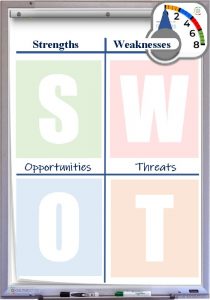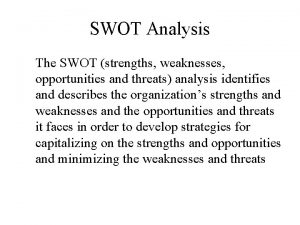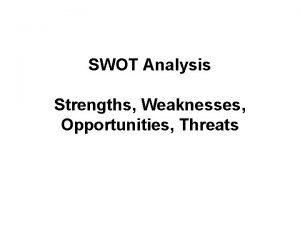Radius Worksheets Strategy SWOT and PEST Strengths Weaknesses







- Slides: 7

Radius Worksheets Strategy

SWOT and PEST Strengths Weaknesses For example: lived experience, passion for change, engaged membership For example: lacking resources, time, clarity of purpose Opportunities Threats For example: trends in industry, media, or special sponsor attention For example: competitor brand, lockdown, pipelines Political Economic Factors: Opportunities: Threats: Technological Socio-cultural Factors: Opportunities: Threats: © Radius Networks Ltd

Linked Strategies What are the most relevant parts of your organisation’s strategy for your network? 1. 2. 3. What are the most relevant parts of the D&I strategy for your network? 1. 2. 3. How does your network strategy connect with those pillars above? 1. 2. 3. Talk with your managers, D&I leads, and sponsors about completing these sections, and make sure they understand how your network activities are linked to the overall organisational strategy. This should help with future buy-in. © Radius Networks Ltd

The Business Case Example A Example B Example C Example D Example E Create your own business case from the examples which are most relevant to your network and organisation. Try to be as specific as possible by linking it back to the overarching strategies and published research. This may include: ● ● ● Higher Performance Attracting Talent Understanding workforce and users Better decision making and innovation Employee engagement © Radius Networks Ltd

Making a Statement Why does your network exist? How is your network organised? What guides your activities? Where do you see your network in the future? Some people write a Vision or Mission statement. You can use this as a basis for creating new statements, or simply suggest adopting this model for clarity. © Radius Business Ltd

Examples of key network roles (Co)Chair Deputy Chair Secretary Treasurer Can originate from any part/level of the organisation. Guides the network and play a key role in shaping its agenda and be the lead contact for the Executive Sponsor. Is ideally representative of the network’s target employee group and is not filled by someone from an HR or Diversity function. Supports the activities of the Chair and coordinates the Stream-Leads (see below). The deputy is often seen as a future successor for chair. Provides traditional secretarial function such as minute keeping, organising and coordinating meetings and other operational matters. Can be held by either HR staff or network member. Manages budget and funding strategy. Can be held by either HR staff or network member. Communications Events and Membership Learning and Development Responsible for the development and implementation of the communication plan. Activities may be targeted at improving awareness of current initiatives, highlighting key achievements, and promoting awareness and advocacy for the network. Coordinates the planning and execution of key network events, as well as managing membership engagement and recruitment. Coordinates the development and delivery of key training and education initiatives. Ally Reps Organisers Regional Reps Does not identify as a member of the target employee demographic group but provides advocacy and support to champion the interests and activities of the employee network. Assists with the planning and delivery of networking activities on behalf of the employee network. Key point of contact in regional areas, hosts network events and takes a lead in setting up a regional branch to expand coverage. © Radius Business Ltd

Agreed Ways of Working Face to Face Meetings Online Working For example: How often are they? What are they for? How do we run them? How do we improve them? For example: How do we meet (as above)? How do we track activities? How do we embrace agility? Commitment and Accountability Values For example: How do we set expectations? How do we agree role? How do make people accountable? For example: What principles do we have around the way we work? How do we empower active members? Do we walk the talk of our network? You may want to reach an agreement with your team, then create a charter from this and have new key members sign it. © Radius Business Ltd













